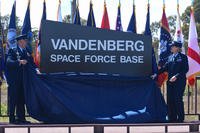MARINE CORPS AIR STATION YUMA, Ariz. – A squadron of MV-22 Ospreys flew in formation from behind a mountain range, their silhouettes barely visible in front of the setting sun. Each Osprey pilot unloaded a special, parachute-rigged container, handcrafted by the Marines waiting for them below.
The Marines are parachute riggers from Air Delivery Platoon, Landing Support Company, Combat Logistics Regiment 17, 1st Marine Logistics Group, and they are experts in the art and science of parachute rigging.
Parachute riggers are essential for transporting heavy loads of food, fuel and ammunition with aircraft such as the C-130 or Osprey, enabling ground units to receive supplies faster, safer and at farther distances than they would from a convoy. This is especially important in an expeditionary environment where ground forces are expected to move at a rapid rate.
“We can package whatever supplies the ground units need into a container delivery system,” said Gunnery Sgt. George Martinez, staff noncommissioned officer-in-charge, Air Delivery Platoon, LS Co., CLR-17. “Each CDS can range from 500 pounds to 2,200 pounds. We can also go on a bigger scale and use a different system to rig something up to 40,000 pounds. With proper preparation and coordination, we can provide immediate resupply to forward units.”
The Marines are currently supporting Weapons and Tactics Instructor Course 1-14 at Marine Corps Air Station Yuma, Ariz., where they have used their rigging skills to help qualify Osprey pilots. The WTI course is a biannual, graduate-level Marine aviation instructor training course designed to provide pilots with training on aviation weapons systems and tactics. Parachute riggers also gain valuable experience from supporting those types of training events.
The containers used during WTI 1-14 were made by each parachute rigger from supplies such as netting, tires or wooden pallets.
Another part of their training is graduating the Army Basic Airborne Course. Each rigger sports the Parachutist Badge or “jump wings” on his or her utilities and has hours of experience packing and using parachutes for static-line jumps.
“From the moment [the riggers] start training to pack their own parachutes, it’s essential for them to show maturity and the capability to perform their job,” said Martinez, a native of Oxnard, Calif. “There’s a great deal of responsibility put on [parachute riggers] because, ultimately, peoples’ lives are at stake and everyone in the community takes that very seriously.”
In addition to jump school, the riggers receive advanced training on how to ensure their cargo reaches the drop zone safely.
“During the rigging process, we have Marines that certify as joint airdrop inspectors,” said Martinez. “They ensure the quality and safety of the cargo load in addition to the loadmasters and the crew chiefs of the aircraft, who also conduct their own inspections. We make sure that there are no mistakes because we are responsible for these mission-essential supplies.”
These parachute riggers take pride in their craft and find fulfillment in their ability to effectively support boots on the ground.
“The best part about [the job] is getting to see your hard work drop out of the planes,” said Lance Cpl. Anthony Martini, a parachute rigger with Air Delivery Platoon, LS Co., CLR-17. “We rig up all the loads and to see them [put to use] is really rewarding."

























